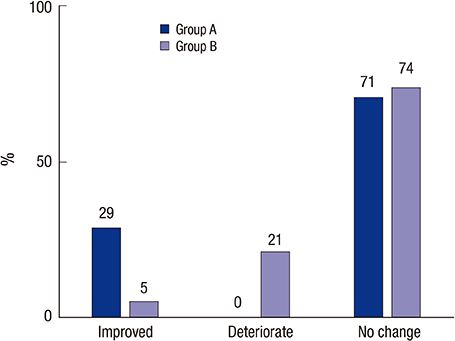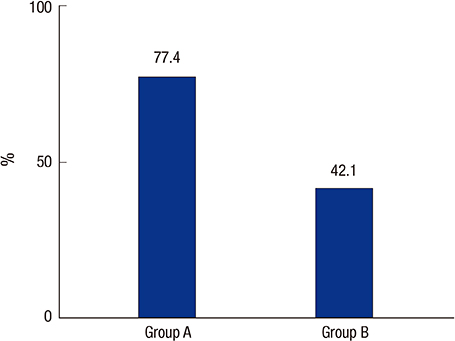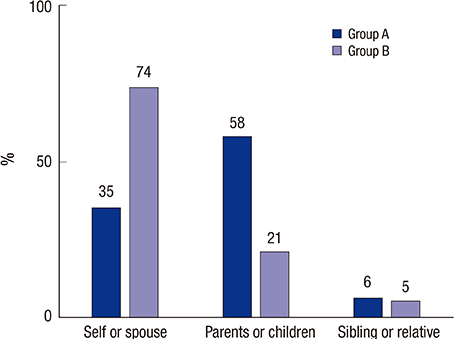J Korean Med Sci.
2015 Jul;30(7):974-978. 10.3346/jkms.2015.30.7.974.
Comparison of Families with and without a Suicide Prevention Plan Following a Suicidal Attempt by a Family Member
- Affiliations
-
- 1Department of Nursing, Soonchunhyang University Hospital, Cheonan, Korea.
- 2Department of Internal Medicine, Soonchunhyang University Hospital, Cheonan, Korea. syhong@sch.ac.kr
- 3Department of Neurology, Soonchunhyang University Hospital, Cheonan, Korea.
- KMID: 2164485
- DOI: http://doi.org/10.3346/jkms.2015.30.7.974
Abstract
- The frequency and extent of the existence of a familial suicide prevention plan may differ across cultures. The aim of this work was, therefore, to determine how common it was for families to develop a suicide prevention plan and to compare the main measures used by families with and without such a plan, after an attempt to commit suicide was made by a member of a family living in a rural area of Korea. On the basis of the presence or absence of a familial suicide prevention plan, we compared 50 recruited families that were divided into 2 groups, with Group A (31 families) employing a familial suicide prevention plan after a suicide attempt by a family member, and Group B (19 families) not doing so. The strategy that was employed most frequently to prevent a reoccurrence among both populations was promoting communication among family members, followed by seeking psychological counseling and/or psychiatric treatment. Contrary to our expectation, the economic burden from medical treatment after a suicide attempt did not influence the establishment of a familial suicide prevention plan. It is a pressing social issue that 38% (19 of 50) of families in this study did not employ a familial suicide prevention plan, even after a family member had attempted suicide. Regional suicide prevention centers and/or health authorities should pay particular attention to these patients and their families.
MeSH Terms
Figure
Reference
-
1. Clayton PJ. Suicide. Psychiatr Clin North Am. 1985; 8:203–214.2. Sudak HS, Ford AB, Rushforth NB. Adolescent suicide: an overview. Am J Psychother. 1984; 38:350–363.3. Lim AY, Lee AR, Hatim A, Tian-Mei S, Liu CY, Jeon HJ, Udomratn P, Bautista D, Chan E, Liu SI, et al. Clinical and sociodemographic correlates of suicidality in patients with major depressive disorder from six Asian countries. BMC Psychiatry. 2014; 14:37.4. Chung JH, Moon K, Kim do H, Min JW, Kim TH, Hwang HJ. Suicidal ideation and suicide attempts among diabetes mellitus: the Korea National Health and Nutrition Examination Survey (KNHANES IV, V) from 2007 to 2012. J Psychosom Res. 2014; 77:457–461.5. Goldfarb S, Tarver WL, Sen B. Family structure and risk behaviors: the role of the family meal in assessing likelihood of adolescent risk behaviors. Psychol Res Behav Manag. 2014; 7:53–66.6. Gil HW, Kim SJ, Yang JO, Lee EY, Hong SY. Clinical outcome of hemoperfusion in poisoned patients. Blood Purif. 2010; 30:84–88.7. Seok SJ, Kim JH, Gil HW, Yang JO, Lee EY, Hong SY. Comparison of patients starting hemodialysis with those underwent hemodialysis 15 years ago at the same dialysis center in Korea. Korean J Intern Med. 2010; 25:188–194.8. Italian Multicenter Group of ICU research (GIRTI). Time oriented score system (TOSS): a method for direct and quantitative assessment of nursing workload for ICU patients. Intensive Care Med. 1991; 17:340–345.9. Waters M, Nightingale P, Edwards JD. A critical study of the APACHE II scoring system using earlier data collection. Arch Emerg Med. 1990; 7:16–20.10. Di Thiene D, Alexanderson K, Tinghög P, La Torre G, Mittendorfer-Rutz E. Suicide among first-generation and second-generation immigrants in Sweden: association with labour market marginalisation and morbidity. J Epidemiol Community Health. 2015; 69:467–473.11. Farrell CT, Bolland JM, Cockerham WC. The role of social support and social context on the incidence of attempted suicide among adolescents living in extremely impoverished communities. J Adolesc Health. 2015; 56:59–65.
- Full Text Links
- Actions
-
Cited
- CITED
-
- Close
- Share
- Similar articles
-
- Correlation between Personality, Family Dynamic Environment and Suicidal attempt among Korean Adolescents Population
- Factors Associated With Suicidal Attempt among Suicidal Ideators of Korean Adults
- Comparative Study of Adolescents' Mental Health between Multicultural Family and Monocultural Family in Korea
- Effect of Attitude Toward Suicide on Suicidal Behavior: Based on the Korea National Suicide Survey
- Suicide prevention by education




